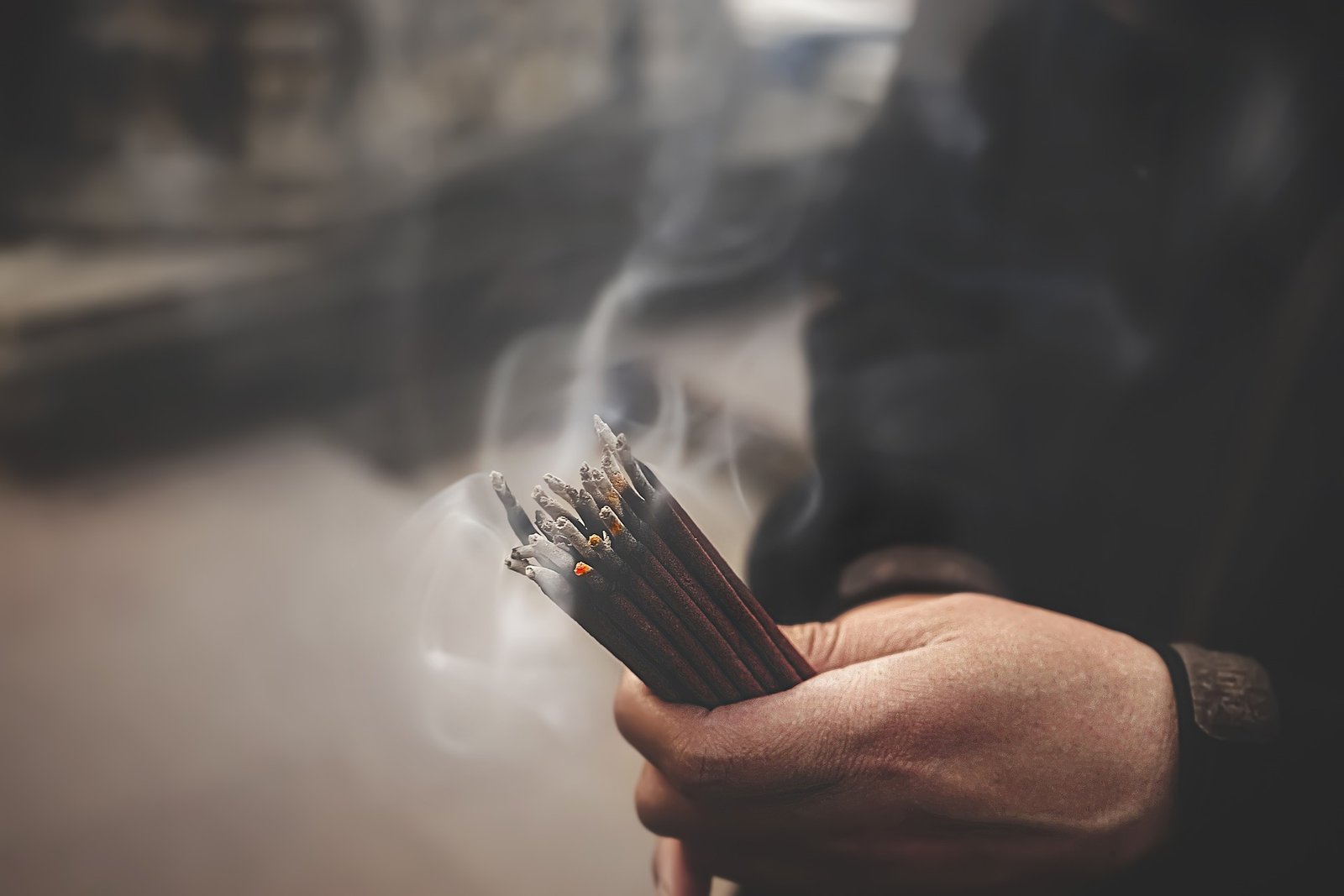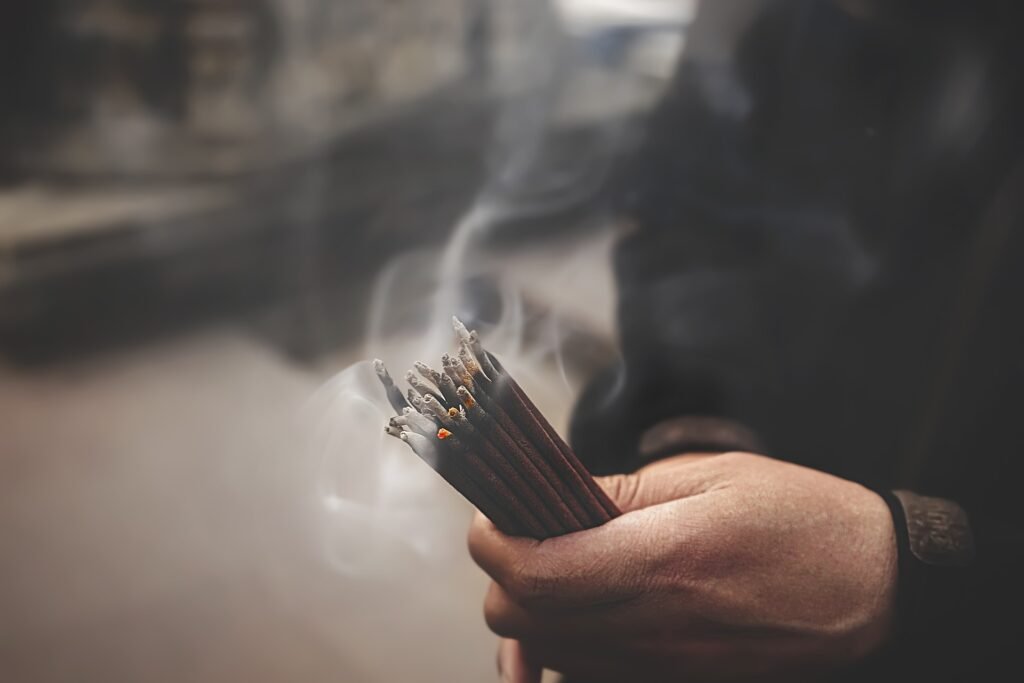Introduction:
From the fragrant corridors of ancient temples to the serene ambiance of contemporary spas, incense has woven its aromatic thread throughout the tapestry of human history. Its mystique and allure have spanned cultures, traditions, and epochs. Yet, in an age where wellness and health are paramount, a pressing question arises: Is incense bad for you? The short answer is: yes, burning incense is bad for you. But the story has some nuances.
As this age-old practice finds its place in modern homes, it’s imperative to dissect the myths, uncover the truths, and truly understand the implications of that fragrant smoke curling up into our spaces. Join us as we embark on a journey to discern fact from fiction, ensuring that your next incense lighting experience is both informed and delightful.
A Brief History of Incense
Incense, in its many forms, has accompanied human civilization’s evolution, marking milestones and rituals, and adding fragrance to our memories and histories.
The Origins and Evolution of Incense Use
From the time of the ancient Egyptians who used it in their religious rituals and burial practices, to the Silk Road merchants who traded it as a precious commodity, incense has been a significant part of various cultures. Burning incense was not just about the fragrance, but also about spirituality, meditation, and in some cases, a mark of opulence.
Its adoption spanned different continents. In the East, particularly in countries like India, Japan, and China, incense became an integral part of religious ceremonies and meditation practices. The Western world too, with its Catholic churches and indigenous rituals, saw the adoption and adaptation of incense burning in its own unique ways.
Societal and Cultural Significance Across the Globe
The burning of incense was not just a practice but a symbol. For some, it represented the ascending of prayers to the divine. For others, it was a tool to purify the surroundings and ward off evil spirits. In many cultures, different fragrances were (and still are) associated with various festivals, seasons, or occasions, making incense an olfactory calendar marking time’s passage.
The intricate rituals and tools – the censers, the specific ways of burning, and even the time of day chosen for burning incense – highlight its deep-rooted significance. Its omnipresence in cultural and religious rituals around the world showcases its universal appeal.
But as we delve deeper into the world of incense, it’s essential to understand what it’s made of, especially in the context of health implications. The composition, as we’ll discover, plays a pivotal role in determining whether the incense is a boon or bane.
The Composition of Incense
Incense, though unified in its primary purpose of releasing aromatic smoke, can vary immensely in its ingredients. The distinction, often, is stark between natural and synthetic variants, each carrying its unique footprint.
Natural vs. Synthetic Incense
- Differences in Ingredients and Production Methods: Natural incense is typically derived from organic materials such as resins, woods, herbs, and essential oils. This form aims to capture the essence of nature and the environment from which it originates. Synthetic incense, on the other hand, is often made using artificial fragrances and fillers, formulated to mimic or enhance specific scents, sometimes even those not found in nature.
- Potential Health Implications: Generally, natural incense is considered safer due to its organic origins. It releases fewer chemicals when burned compared to their synthetic counterparts. However, this doesn’t mean it is entirely risk-free. Synthetic incense, on the other hand, might release harmful toxins due to the artificial compounds and fillers, especially when burned at high temperatures.
Key Components and Their Effects
- Exploring Common Ingredients:
- Resin: Sourced from trees, these are the aromatic tears of nature, often used in incense for their potent fragrances. Examples include frankincense and myrrh.
- Essential Oils: Distilled from plants, these are concentrated essences that carry the scent profile of their source. Lavender, cedarwood, and lemongrass are popular choices.
- Wood: Pieces or powders from trees, like sandalwood or agarwood, that have inherent fragrant properties when burned.
- Brief on Potential Health Benefits or Risks: While many of these natural ingredients, such as lavender essential oil, are lauded for their relaxation and anxiety-reducing properties, it’s essential to approach their smoke with a discerning eye. Some woods, when burned, can produce smoke that may irritate respiratory systems or those with allergies.

The Health Implications of Burning Incense
The comforting ambiance set by a burning stick or cone of incense is undeniable. But beyond its sensory appeal lies a spectrum of health implications that every enthusiast should be aware of.
The Positive Side
- Aromatherapy Benefits: Incense, especially those infused with essential oils, often overlaps with the principles of aromatherapy. Scents like lavender, for instance, are renowned for their ability to promote relaxation and reduce stress. Burning such incense can create an environment conducive to meditation, mindfulness, and relaxation. Read our blog post on how to use Incense for Relaxation for more information.
- Potential Antibacterial Properties: Some studies suggest that certain incense types, like those containing frankincense, have antibacterial properties that can purify the air, making the surroundings cleaner at a microbial level. It’s a throwback to ancient times when incense was believed to ward off evil spirits – today, it might just be warding off harmful bacteria!
Potential Health Concerns
- Indoor Air Quality and Its Significance: When anything burns, it releases particles into the air. Incense is no different. Continuous burning in unventilated spaces can reduce indoor air quality, which could become a concern for those with respiratory conditions like asthma or allergies.
- Research Findings on Prolonged Exposure: Prolonged exposure to any smoke, including that from incense, may pose potential health risks. Some studies have drawn parallels between the particulate matter found in incense smoke and that of cigarettes, raising concerns about long-term inhalation.
- Comparisons with Other Indoor Pollutants: While incense does release particulate matter, it’s essential to put it in perspective. Compared to other indoor pollutants like cigarette smoke, the concentration from incense might be considerably lower. However, this doesn’t negate the need for caution, especially when burning incense regularly.
Tips for Safe and Mindful Incense Usage
Burning incense can be a sensory delight, but ensuring that this ritual is both safe and rewarding requires a touch of mindfulness. Here’s how you can continue to enjoy the ethereal aroma without compromising health.
Choosing the Right Incense
- Opting for Natural Over Synthetic: When in doubt, it’s always better to lean towards nature. Natural incense, made from organic materials, often emits fewer chemicals when burned. Seek brands that prioritize transparency in their ingredient list.
- Brands that Prioritize Health and Sustainability: In a market flooded with choices, select brands that uphold ethical sourcing, sustainability, and health-conscious production. It’s not just about the aroma; it’s about the ethos behind every stick or cone.
Proper Ventilation is Key
- Ensuring Proper Air Circulation During and After Burning: This is a golden rule. Always burn incense in a well-ventilated area to ensure the aromatic smoke doesn’t become an indoor pollutant. It’s about enjoying the fragrance, not being overwhelmed by it.
- The Importance of Not Burning Incense in Closed, Unventilated Spaces: Remember, while the scent might be pleasing, smoke in a closed space can accumulate and potentially affect respiratory health. Keep windows open or ensure an airflow pathway.
Quantity and Duration
- Moderation as the Best Approach: It’s tempting to immerse oneself in the captivating aroma of incense, but moderation is key. Limit the number of sticks or cones you burn in a session.
- Guidelines for How Often and How Long to Burn Incense: While there’s no hard and fast rule, listening to your environment and your body is essential. If you find the air getting too smoky or feel any discomfort, it might be time to put out the incense and ventilate the room.

Common Myths and Misconceptions
As with many ancient practices that have been carried into modern times, myths and misconceptions have inevitably cropped up around the use of incense. Let’s address some of the most prevalent ones, bringing clarity with the light of scientific understanding.
- “All Incense is Toxic”: This blanket statement ignores the vast diversity in incense composition. While some poorly-made, synthetic incense might release harmful compounds when burned, many natural alternatives produce far fewer toxins.
- “Incense Can Cure Diseases”: While certain properties of incense, like aromatherapy benefits or potential antibacterial effects, can contribute to well-being, claiming it as a cure for diseases is an exaggeration. Always consult medical professionals for health concerns.
- “Burning Incense is Equivalent to Smoking Cigarettes”: Some studies have drawn parallels between incense smoke and cigarette smoke in terms of particulate matter. However, the frequency and volume of exposure differ drastically. It’s essential to differentiate occasional incense burning from habitual cigarette smoking.
- “There’s No Way to Safely Enjoy Incense”: With proper ventilation, moderation, and by choosing natural, high-quality products, one can definitely enjoy incense with minimized risks. It’s all about informed choices.
- “All Natural Incense is Safe”: While natural incense generally contains fewer synthetic chemicals, it’s still crucial to ensure good ventilation when burning and to be cautious if you have respiratory issues or sensitivities.
Dispelling these myths allows for a more informed approach to incense. Knowledge, as they say, is power. So, having navigated through the world of incense, its history, composition, health implications, and myths, it’s time to answer the pivotal question that sparked this journey.
The Verdict: Is Incense Bad for You?
The nuanced world of incense doesn’t lend itself to a straightforward “good” or “bad” label. Instead, it’s a delicate balance of its therapeutic effects, the joy it brings, and the potential health considerations.
When used mindfully—opting for natural variants, ensuring ventilation, and burning in moderation—incense can certainly be a delightful and relatively safe addition to one’s lifestyle. Yet, it’s essential to be aware of the potential risks and make choices that prioritize health and well-being.
Incense is, at its heart, an ancient ritual. A bridge between the realms of sensory pleasure and spiritual devotion. As with many pleasures in life, the key lies in balance, respect, and understanding.
Conclusion
Incense, with its aromatic tendrils of smoke and a history rooted deep in spiritual and cultural practices, remains a captivating enigma for many. Its dual nature—being a source of pleasure, relaxation, and potential therapeutic effects, juxtaposed against concerns about air quality and health—means its use requires an informed, balanced approach.
Through understanding and respect for this age-old tradition, one can strike a harmonious balance. It’s not about fear, but about knowledge. By recognizing the potential risks and adopting best practices, we can savor the profound sensory and spiritual pleasures incense offers while also prioritizing our well-being.
In the end, much like enjoying a fine wine or savoring gourmet chocolates, it’s all about relishing the experience mindfully, responsibly, and with gratitude for the ancient traditions that gift us these moments of serenity.





